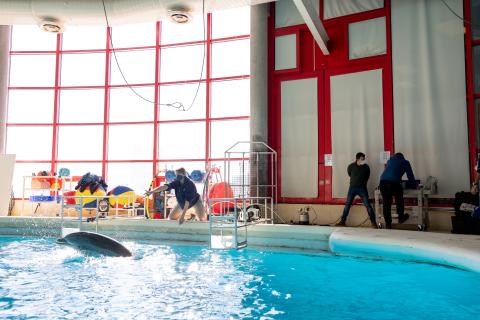When the Deepwater Horizon oil spill occurred in 2010, many thought marine mammals would avoid the oil. This turned out to not be true. Daily life for these animals, known as cetaceans, involved swimming through floating slicks as they surfaced to breathe.
In the immediate wake of the oil spill, more than 1,000 dolphins died. Assessments of the damage after the spill found that tens of thousands of marine mammals were exposed to the surface slick, leading to a constellation of negative health outcomes, including lung disease and pneumonia.
Even today, very little is known about how marine mammals interact with oil spills. To effectively plan for response and restoration, and to identify ways to mitigate threats, scientists need a better understanding of how cetaceans are harmed by surface oils and dispersants.
The Marine Mammal Disaster Response project, selected by the Deepwater Horizon Open Ocean Trustee Implementation Group as part of the 2019 Restoration Plan (PDF, 493 pages), includes a component aimed at improving scientists’ knowledge of threat factors. Such factors include how particular thicknesses or qualities of oil pose different risks to marine mammals, or if there is a window of time after a spill where response activities are optimally beneficial.
The first of a three-part data gap project recently wrapped up, examining the dynamics of a dolphin’s breath at the surface to better understand how much floating material may make it into the animals’ lungs. To collect this information, scientists took high-speed videos of dolphins doing what comes naturally to all mammals: breathing air. The video captured various types of inhalations and exhalations, and the droplets they created.
The videos will inform the next phase of the study in 2023. Johns Hopkins University scientists will build a functional replica of a dolphin blowhole, based off videos analyzed, for further lab experiments. The blowhole replica will simulate “breaths” in controlled tanks of seawater with slicks of different types of crude oil and dispersant chemicals to understand the quantities of chemicals that dolphins may inhale.
Ultimately, the work will inform future restoration activities. Examples could include the timing of corralling marine mammals away from spills, knowing which diagnostic or other intervention efforts are needed for stranded animals at different exposure levels, or making recommendations for air sampling protocols at or near the water’s surface during a spill event. Filling in data gaps could also allow for recommendations of appropriate dispersants to use under certain conditions, or identifying exposure limits that correspond to expected health or population impacts.
Participants in this phase of the project include NOAA, Coastal Response Research Center, the National Aquarium, and Johns Hopkins University.
We also send restoration updates out via email. If you haven't already, please take the opportunity to sign up for email updates today to receive the latest news from all the Deepwater Horizon Trustees.


